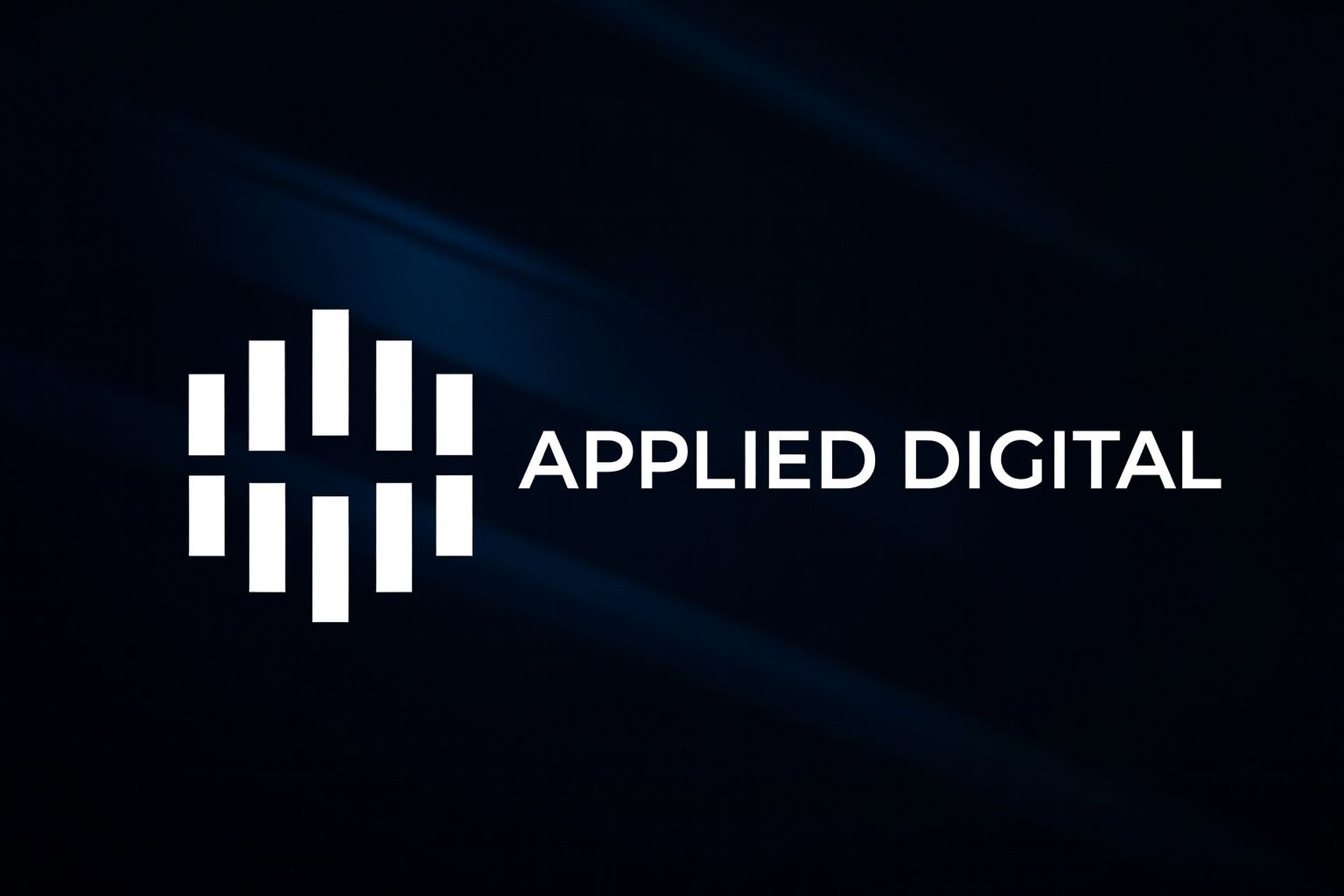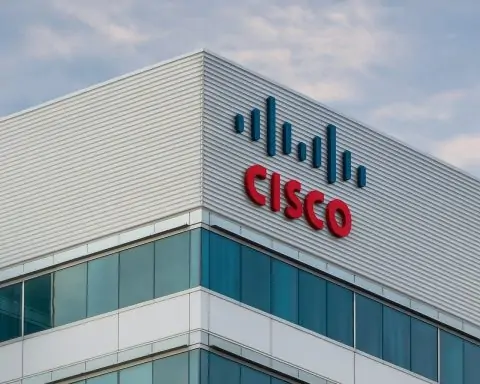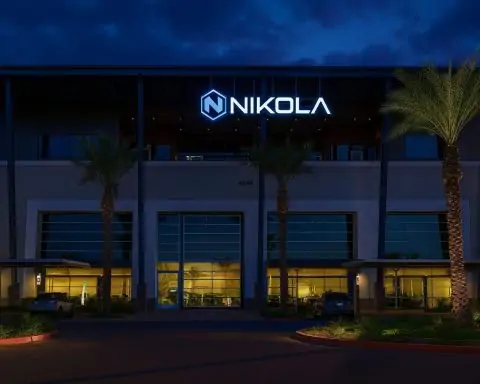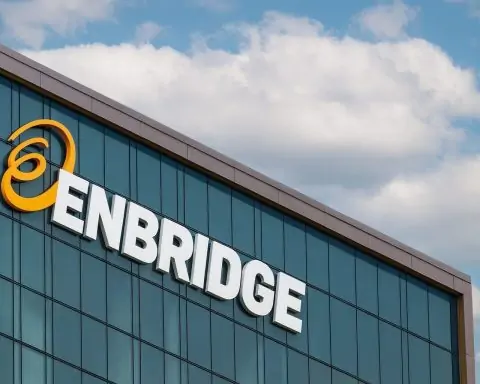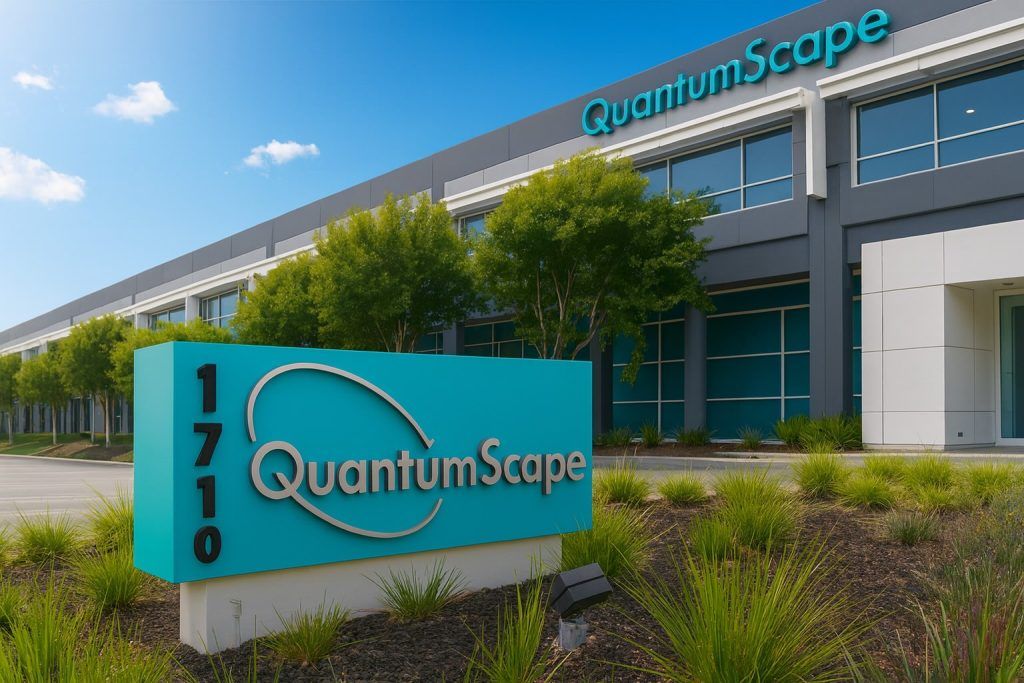Key Facts (Oct 3–6, 2025)
- Stock Soars on AI Hype: Applied Digital Corp. (NASDAQ: APLD) – a data-center firm pivoting from crypto mining to AI infrastructure – saw its stock surge ~19% from ~$22 at September’s end to the high-$20s by Oct 2 [1]. Shares hit all-time closing highs around $26.5 on Oct 3, capping a >200% year-to-date rally amid frenzied AI optimism. The stock has traded in a volatile 52-week range of $2.55–$33.07 [2], reflecting explosive growth bets and extreme swings (5-year beta >6).
- Earnings on Deck: Applied Digital is set to report fiscal Q1 2026 results on October 9, 2025. Analysts expect a quarterly loss of ~$0.11 per share on ~$52 million revenue, versus a -$0.12 EPS loss on $38 million revenue in the prior quarter [3]. The company has scheduled an investor call for Oct 9 to discuss results [4]. Anticipation of this “earnings catalyst” helped fuel recent trading, with traders positioning ahead of the report.
- Big AI Deals Drive Expansion: In late August, Applied Digital finalized a 150 MW data-center lease with CoreWeave, a major AI cloud provider, bringing CoreWeave’s total capacity at APLD’s North Dakota campus to 400 MW. These 15-year leases are worth about $11 billion in contracted revenue [5], underscoring APLD’s successful pivot from crypto clients to long-term AI infrastructure deals. The flagship “Polaris Forge 1” campus can scale to 1 GW of IT load, using proprietary waterless cooling and cheap power to serve power-hungry AI workloads [6].
- $3 Billion Expansion & Power Play: On Aug 18, Applied Digital announced it will break ground on “Polaris Forge 2,” a $3 billion, 280 MW AI data center campus in North Dakota, slated to start operating in 2026 and reach full capacity by early 2027 [7]. Management revealed it is in advanced talks with a U.S. investment-grade hyperscaler to anchor this new campus [8]. The project spans 900+ acres with power secured via local cooperatives [9] – a critical advantage as industry experts warn of potential power shortages for AI data centers in coming years [10].
- Financial Health & Fundraising: For FY2025 (ended May 31, 2025), APLD posted $144.2 million revenue (+6% YoY) and a net loss of $161 million (–$0.80 EPS) [11]. Although adjusted EBITDA turned positive (~$19.6 M) [12], heavy development costs kept net income deep in the red. The company shored up liquidity by raising $268.9 M after FY25 via at-the-market stock sales and preferred equity [13]. In late September, APLD also filed an automatic shelf registration to sell ~8.39 million shares (est. $197 M proceeds) to fund its ambitious build-outs [14] – highlighting both the capital intensity of its expansion and investors’ willingness to fund its AI vision.
- Analyst Buzz and Outlook: Wall Street is increasingly bullish on APLD’s prospects amid the AI “gold rush.” Roughly a dozen analysts rate the stock a “Buy”, with price targets ranging from ~$13 up to $30 [15]. (Notably, the high end $30 target implies further upside and was cited as a “Strong Buy” consensus by some reports [16].) However, the stock’s rapid rise above the ~$20 average target has some experts cautioning that the market may be ahead of fundamentals [17]. The Motley Fool observes that data center capacity is becoming scarce, a “huge opportunity” for Applied Digital – which has already secured power and fast-build capabilities that position it to capitalize on surging AI demand [18] [19]. Management is targeting $1 billion in operating profit within 5 years [20], but achieving that will require flawless execution. Concentration risk is also a concern: one anchor client (CoreWeave) will account for much of APLD’s future revenue [21], and any pullback or delay by such a customer could impact growth. Upcoming earnings and deal announcements will be key tests of whether APLD can justify the hype.
Recent News & Stock Performance (Oct 3–6, 2025)
Applied Digital entered October 2025 as one of the market’s hottest tech stories. Between Oct 3 and Oct 6, no new company-specific announcements were released, but APLD’s stock held near record highs as analysts and media continued to digest the late-September surge. On Oct 3, APLD closed around $26.53 (an all-time closing high [22]), essentially flat (+0.2%) on the day after an explosive 19% two-day rally earlier in the week. This stability at high levels suggested traders were consolidating gains ahead of the forthcoming earnings report.
Market commentators highlighted the factors behind APLD’s 200%+ year-to-date climb. Chief among them: the company’s aggressive pivot into AI data centers and the multi-billion-dollar CoreWeave lease deals announced in recent months. The late-September news of expanded contracts “boosted Applied Digital’s total contracted capacity to 400 MW” and validated its transformation from a crypto miner to an “AI Factory” provider [23]. Speculation also swirled that Applied Digital might land additional hyperscaler clients, after the company confirmed it’s negotiating with a major cloud player for its new campus [24]. This rumor of an imminent hyperscale cloud deal was credited with igniting an Oct 1–2 buying frenzy [25] [26]. As Tech Space 2.0 noted, “optimism over an imminent hyperscaler agreement” on Oct 1 sent APLD stock up ~9% in one day [27].
By the weekend (Oct 4–5), financial outlets were buzzing about whether Applied Digital’s rally could sustain. The Motley Fool published a piece titled “Think It’s Too Late to Buy Applied Digital Stock? Here’s 1 Reason Why the Rally May Continue” (Oct 5) arguing that demand for AI-ready data center capacity still far outstrips supply, giving APLD a long runway [28]. It pointed out that “data center capacity could be increasingly difficult to come by in coming years, which is a huge opportunity for Applied Digital” [29]. Another Motley Fool analysis (syndicated on Nasdaq, Oct 6) predicted “Applied Digital Stock Will Soar in 2026”, citing the company’s $11 billion in long-term AI contracts and new Polaris Forge campus as reasons analysts have a strong buy on the stock with a ~$30 target [30]. Such bullish commentary from popular outlets likely helped keep investor enthusiasm high through Oct 6.
Broader market sentiment also played a role. The first week of October saw a continued “AI rally” on Wall Street, lifting many stocks tied to artificial intelligence. Applied Digital, often grouped with AI infrastructure plays, benefited from this trend. Notably, its strategic partner CoreWeave (a fast-growing AI cloud firm backed by NVIDIA) was reportedly preparing a blockbuster IPO around that time, which added to the euphoria for AI-exposed names [31]. Traders looking for the “next big AI winner” in the data center space have zeroed in on APLD, given its relatively small market cap (~$6–7 billion) and explosive growth narrative.
Despite the bullishness, some observers urged caution. Simply Wall St published an Oct 5 analysis questioning whether APLD’s valuation had run ahead of itself. It noted the company’s recent shelf offering (late Sept) to raise nearly $200 million, suggesting that continuous capital raises are needed to fund construction, which could dilute existing shareholders [32] [33]. The piece modeled aggressive growth (74% annual revenue CAGR through 2028) and still arrived at a fair value near $21/share, about 20% below APLD’s early October price [34]. This more skeptical take underscores that, while momentum is strong, investors are essentially betting that Applied Digital will execute flawlessly on its massive projects and win more mega-deals in the AI arena. Any hiccup – a delayed facility, cost overrun, or loss of a key client – could trigger a sharp correction in such a highly volatile stock (APLD’s 1-year beta is above 6, and it has logged nearly a hundred daily moves over ±5% in the past year [35] [36]).
Financial Results & Forecasts
In early October, investors were keenly awaiting Applied Digital’s first quarter FY2026 earnings (covering June–Aug 2025) due on Oct 9. MarketBeat reported the consensus forecast as a ($0.11) loss per share on ~$52.3 million revenue, reflecting ongoing net losses as the company scales up [37]. This outlook is a sequential improvement over the fiscal Q4 2025 results (−$0.12 EPS on $38 million revenue) and if met, would imply ~37% quarterly revenue growth. Such growth aligns with APLD’s recent performance – in the fiscal year 2025, revenue was $144.2 M (up 6% YoY) and Q4 2025 revenue jumped 41% year-on-year [38]. However, profitability remains distant: FY2025 net loss was $161 M [39] and even on an adjusted basis the company lost ~$12.5 M [40]. High depreciation, interest on project debt, and development costs for new data centers are weighing on the bottom line [41].
Analysts, for now, appear comfortable with losses as long as Applied Digital shows progress toward monetizing its mega-projects. The upcoming earnings call will be scrutinized for guidance on revenue ramp from CoreWeave’s leases and any updates on new customer wins. Notably, the first 100 MW of the CoreWeave deployment is scheduled to go live by Q4 2025 (late calendar 2025) [42], which should substantially lift APLD’s revenues in coming quarters. Investors will also watch gross margins and cash burn. In the last reported quarter, APLD’s net margins were around –107% [43], illustrating that current revenues don’t yet cover operating and financing costs. The debt-to-equity ratio is ~1.3 [44], reflecting considerable leverage used to finance data center construction. Any improvement in cash flow or EBITDA margins (perhaps via operational efficiencies or higher utilization of facilities) would be a positive surprise.
On the balance sheet front, Applied Digital’s strategy has been to continually raise capital to fund expansion. In addition to the ~$269 M equity raised after May 2025 [45], the company’s September 2025 shelf registration indicates readiness to tap equity markets again for ~$196–200 M [46]. While these injections strengthen APLD’s cash reserves, they also raise dilution concerns. Some analysts have pointed out that the Series G convertible preferred stock financing (up to $300 M authorized) could be dilutive as it converts to common shares, though the conversion floor price was recently hiked to $22 to mitigate excessive dilution [47] [48]. In short, Applied Digital’s financial tightrope involves balancing aggressive growth investments with maintaining sufficient liquidity. The company had a current ratio below 0.8 as of mid-2025 [49], so it will likely need either improved operating cash flow or additional financing in coming months to comfortably fund projects like Polaris Forge 2. Investors seem willing to bankroll APLD’s expansion (given the strong stock demand), but each earnings report and SEC filing is being scrutinized to ensure the growth story is on track.
Major Deals, Partnerships & Expansion Plans
Applied Digital’s recent trajectory is defined by blockbuster deals and capacity build-outs aimed at making it a go-to provider for AI infrastructure. The most headline-grabbing development is the series of long-term leases with CoreWeave, one of the fastest-growing AI cloud providers (backed by firms like NVIDIA). In May 2025, Applied Digital announced two initial 15-year leases with CoreWeave for 100 MW + 150 MW at its Polaris Forge 1 campus; then on August 29, it inked a third lease for an additional 150 MW [50]. Together, these deals commit CoreWeave to 400 MW of capacity at APLD’s North Dakota facilities, and are estimated to be worth ~$11 billion in contracted revenue over their terms [51]. This is a transformative, game-changing contract for Applied Digital – essentially providing a decade-plus revenue pipeline and a solid economic justification for its rapid expansion. As one report noted, “This long-term partnership directly strengthens Applied Digital’s pursuit of recurring revenue… but it also deepens customer concentration risk” (with CoreWeave becoming an outsized part of APLD’s future) [52].
Beyond CoreWeave, Applied Digital has been actively courting other big fish. CEO Wes Cummins revealed that the company is in advanced negotiations with a large, investment-grade hyperscaler – widely speculated to be a major cloud provider – to become a tenant at the upcoming Polaris Forge 2 campus [53]. This hints that another significant lease could be on the horizon. In the Polaris Forge 2 announcement (Aug 18), Cummins emphasized that surging demand for AI compute prompted APLD to fast-track this $3 billion project and that “we have strong interest from multiple parties”, making it timely to proceed with construction [54]. If and when a new hyperscaler deal is confirmed, it could rival the CoreWeave agreement in scale and be a major catalyst for the stock. Analysts from Roth Capital and others have cited the likelihood of additional AI customer wins as a reason for their bullish stance [55], essentially viewing APLD as one of the few independent players with ready capacity to offer to hyperscalers hungry for data center space.
On the infrastructure side, Applied Digital’s projects are notably ambitious:
- Polaris Forge 1 (Ellendale, ND): This is the company’s flagship campus, which will house CoreWeave’s 400 MW leases. It’s designed to scale up to 1 gigawatt eventually [56], an unprecedented capacity for a single third-party data center site. APLD touts proprietary designs like waterless cooling and high-density power distribution (rack loads up to 120 kW, vs ~10–20 kW typical) to support AI supercomputing clusters [57] [58]. The campus leverages North Dakota’s cool climate and low-cost power (including renewables) to improve efficiency – a recent study claimed $2.7 B in cost savings over 30 years due to these advantages [59]. It’s also an award-winning site: Datacloud named Polaris Forge 1 the “Best Data Center in the Americas 2025.” [60] This recognition boosts APLD’s credibility as a serious player in data center engineering.
- Polaris Forge 2 (Harwood, ND): Announced in Aug 2025, this second campus represents an even bigger bet. Phase 1 is 280 MW with potential to expand beyond that [61]. APLD lined up 900+ acres of land and a dedicated power supply through the Cass County Electric Cooperative for Polaris Forge 2 [62]. Groundbreaking is happening in fall 2025 so that initial capacity can come online by late 2026 [63]. The project is not yet tied to a specific customer contract (aside from the hinted negotiations), but it positions Applied Digital to accommodate the next wave of AI infrastructure demand – essentially, building it so they will come.
- Ellendale “AI Factory” and Other Sites: Applied Digital uses the term “AI Factory” to describe its data centers, signaling a productized approach to delivering compute power. The North Dakota footprint is the primary focus, but the company could replicate this model in other locations long-term (taking advantage of cheap power locales). For now, North Dakota’s pro-business environment and energy resources have made it the epicenter of APLD’s expansion [64]. State officials (including the Governor) have publicly lauded Applied Digital for investing in rural communities and powering economic growth in the region [65] [66].
Applied Digital’s capital partnerships have been crucial in funding these expansions. In January 2025, the company struck a deal with Macquarie Asset Management (MAM) for up to $5.0 billion in perpetual preferred equity financing [67] – essentially a war chest to build data centers. An initial $900 M from Macquarie is being used at Ellendale (Polaris Forge 1) to refinance debt and inject cash [68], and MAM can deploy billions more as APLD launches new projects (for a 15% equity stake in the HPC business) [69]. Additionally, a consortium of banks led by SMBC (Sumitomo Mitsui Banking Corp) provided a $375 M project financing facility [70] [71]. These large financings underscore confidence from institutional investors in APLD’s vision. NVIDIA has also invested indirectly – it participated in a $160 M private placement in 2024 and holds 7.7 million APLD shares (as of mid-2025), aligning the company with the leading GPU maker’s ecosystem [72]. Such alliances not only bring capital but also validate Applied Digital’s strategy to build AI-tailored data centers (which, incidentally, will consume thousands of NVIDIA GPUs – a win for NVIDIA as APLD expands [73] [74]).
Analyst & Expert Commentary
Wall Street coverage of Applied Digital has evolved from niche to mainstream as the stock’s price and profile have soared. According to MarketBeat, as of early October, 12 analysts cover APLD with a consensus “Buy” rating and an average price target around $15–21 [75]. This average target lags the current share price, reflecting that many analysts set their targets when APLD was much lower; however, several firms have been racing to raise their estimates. For instance, Roth Capital in September lifted its target (reportedly toward the high-$20s) citing APLD’s better-than-expected AI demand pipeline [76]. High-end targets now reach $30 [77], which bullish commentators view as attainable if the company continues to announce major deals. Yahoo Finance data shows APLD’s market cap hovering ~$7 billion and notes the stock is valued at ~6x management’s long-term profit goal (of $1 B operating profit) – suggesting significant upside if that goal is met [78].
Importantly, some analysts urge caution on valuation. Tech Space 2.0 observed that APLD’s share price (mid-$20s) in late Sept already “exceeds the consensus target (~$20.55), prompting some analysts to suggest the market may be ahead of fundamentals.” [79] Those fundamentals include the fact that APLD is not yet profitable and carries substantial debt, which introduces risk if AI demand falters. Additionally, the concentration of revenue in one customer (CoreWeave) and ongoing share dilution are often flagged in research reports as risks [80] [81]. Simply Wall St, as mentioned, calculated a fundamental fair value near $21 (20% below the Oct 3 price) assuming robust growth but also high capital expenditure needs [82].
Meanwhile, financial media and investing sites have been largely positive, framing Applied Digital as a prime beneficiary of the AI boom – albeit with the caveat of volatility. The Motley Fool has featured APLD in multiple articles, calling it an “underappreciated AI stock” that could “double within three years” due to undervalued data-center capacity [83] [84]. One Fool analyst noted that leading hyperscalers like Google and Microsoft are flush with resources to build their own data centers, “however, the demand for AI is accelerating, and data centers require lots of power to operate. Some analysts see the potential for a power shortage in the next five years, but Applied Digital has secured power for its facilities that will be increasingly valuable.” [85] This insight encapsulates APLD’s bull case: it has positioned itself in front of a huge secular trend (AI infrastructure) and locked down the two key inputs – physical capacity and power – in a way that few small companies have. It has also dramatically shortened its build times for new facilities (from ~24 months to ~12 months, according to management [86]), which could let it capture opportunities faster than lumbering peers.
Industry experts have also weighed in on Applied Digital’s role in the broader data center landscape. APLD is often compared to Equinix (EQIX) and other data center REITs, but its specialization in high-performance computing (HPC) sets it apart [87]. Essentially, Applied Digital isn’t competing to host generic enterprise servers; it’s building GPU-rich “AI factories” that serve clients with specific high-density, high-power needs. Its closest peer is arguably CoreWeave itself, which both relies on APLD’s infrastructure and competes in providing AI cloud services [88]. This symbiotic relationship (CoreWeave as partner-client) is unusual – CoreWeave leases APLD’s data halls to expand its own AI cloud, rather than APLD offering cloud services directly. For now, this suits Applied Digital, which can focus on being a landlord/operator of advanced facilities without needing to develop AI software or platforms. It’s a similar model to a landlord providing factories to a tenant – albeit factories filled with cutting-edge chips instead of machines.
During this Oct 3–6 period, one notable development was increased retail and online interest in APLD. The stock trended on platforms like Reddit’s investing forums, with debates on valuation and sustainability of the rally. While not a traditional analyst source, this retail enthusiasm (and sometimes skepticism) is part of why APLD has seen such high trading volumes (20–30+ million shares traded on many days in late Sept/early Oct [89] [90]). The high beta and momentum attracted short-term traders as well. At the same time, some institutional investors were quietly accumulating: for example, regulatory filings showed hedge funds and asset managers increasing positions in Q3 2025, betting that Applied Digital’s AI pivot will pay off long-term [91]. The mix of “true believers” versus profit-takers makes for volatile trading, and analysts have warned that any sign of a slowdown could trigger profit-taking after such a parabolic rise [92].
To sum up the sentiment: excitement is high, but expectations are even higher. As CNBC commentators put it in broader market discussions, the AI theme has created rich valuations that require real results to back them up. Applied Digital is now under the microscope to deliver on its promises – a fact well understood by both its champions and critics.
Industry Context: From Crypto Mines to AI ‘Factories’ and Power Constraints
Applied Digital’s story mirrors a larger trend in tech: the evolution from cryptocurrency mining infrastructure to AI computing infrastructure. Just a couple of years ago, the company (then known as Applied Blockchain) primarily hosted crypto mining rigs. However, as crypto prices faltered and “blockchain hype” cooled, APLD smartly redirected its resources into the booming market for AI and HPC data centers [93]. This move has proven prescient. Demand for AI model training and inference has skyrocketed in 2023–2025, fueled by advancements in generative AI, and companies are racing to secure the specialized facilities needed to run power-hungry AI workloads. Traditional data centers often lack the necessary power density and cooling for racks filled with thousands of top-end GPUs. Applied Digital recognized this gap and began marketing its facilities as ready-to-go “AI Factories,” emphasizing features like 100% uptime power, liquid and air cooling innovations, and locations with abundant electricity.
One can view APLD’s North Dakota campuses as part of a new “AI infrastructure boomtown” phenomenon. Similar to how certain regions saw data center booms for crypto mining (due to cheap power and cold climates), now those same advantages are being repurposed for AI. North Dakota offers electricity rates reportedly around 3–4 cents per kWh (thanks in part to wind energy and low population density) – a big draw when electricity is one of the largest operating costs for any data center. Moreover, the cool climate reduces cooling costs, especially important since AI hardware can run hotter than regular servers. Applied Digital’s engineering claims, like a PUE (Power Usage Effectiveness) of 1.18 at Polaris Forge (meaning very efficient power usage) [94] [95], suggest it’s pushing the envelope in efficiency, which can be a competitive edge as clients look to manage their carbon footprint and operating expenses.
Another crucial context is the role of power infrastructure. As the Motley Fool highlighted, there’s a looming concern about power grid limitations slowing down the expansion of AI computing [96]. Training a single large AI model can consume megawatt-hours of energy; now multiply that by the growing number of models and services, and you have an immense strain on data center power availability. Some industry insiders even warn of a “GPU and power shortage” – GPUs being scarce due to high demand, and suitable power-fed facilities being equally scarce. Applied Digital has effectively secured large blocks of power ahead of time (e.g. via agreements with utilities like Cass County Electric Co-op [97]), which not only enables its own sites but could turn into a selling point: clients might go with APLD simply because it can plug them in faster than if they built from scratch and waited for grid upgrades. In other words, power is the new gold in the AI rush, and APLD staked its claim early.
The company’s pivot also speaks to a broader convergence of crypto and AI infrastructure. Many former crypto-mining facilities or companies are retooling for AI, since both require similar high-density computing setups. However, AI workloads (like training ChatGPT or running large language models) arguably have more staying power and growth ahead than the volatile, speculative crypto mining field. This bet on AI appears to be paying off for APLD. It’s even won surprising accolades – for example, being named the top data center operator in the Americas for 2025 by an industry group [98], something few would have imagined when it was known mostly for blockchain hosting. Competitors and peers are taking note: traditional data center REITs are investigating ways to increase their high-density offerings, and cloud giants (AWS, Google, Microsoft) continue building out their own capacity. Yet, given how red-hot AI demand is, even the biggest players are sometimes capacity-constrained, leading them to consider outside partners. This dynamic underpins why a hyperscaler might lease from Applied Digital rather than do everything in-house – time-to-market and sheer demand overflow.
Finally, it’s worth noting the environmental and regulatory angle. Large-scale power usage can attract scrutiny. North Dakota’s embrace of projects like Applied Digital’s comes with expectations of using renewable energy and contributing to local economies (jobs, tax base) rather than just gobbling power. APLD has emphasized sustainability in press releases, pointing to renewable integration and efficiency measures [99]. If the company can continue to align with regional interests (as evidenced by supportive quotes from the Governor and utility CEOs in its announcements [100] [101]), it likely smooths the path for further expansion. On the other hand, if power grids get strained or if bitcoin mining sees a resurgence (competing for the same electricity), there could be political or public pressure down the line. For now, though, AI data centers are seen as drivers of innovation, and Applied Digital is riding that positive wave.
Upcoming Catalysts & Conclusion
As the period of Oct 3–6, 2025 comes to a close, Applied Digital finds itself at a critical juncture – validated by markets but now tasked with delivering results. The immediate next catalyst is the Q1 2026 earnings report on Oct 9, where investors expect to hear updates on revenue traction and perhaps new deals. Any hint of a new hyperscaler lease or an upside surprise in earnings could propel the stock further. Conversely, if results or commentary disappoint (for instance, if ramp-up with CoreWeave is slower than expected or cost overruns are creeping in), the stock’s lofty valuation could face a sharp correction.
Beyond earnings, APLD’s investor day and annual shareholder meeting (scheduled for Nov 5, 2025) [102] may provide more color on long-term plans. There’s also the broader market environment – with interest rates, tech stock rotations, and AI hype cycles all potentially influencing APLD’s stock volatility. Given the high short interest some momentum names attract, one cannot rule out price swings unrelated to fundamentals as well.
In summary, Applied Digital has, in a few short months, transformed from a little-known small-cap into a poster child of the AI infrastructure boom. Its stock performance between Oct 3 and Oct 6, 2025 reflects a market that is enthralled by the company’s bold moves – multi-billion-dollar contracts, massive new campuses, and alignment with AI heavyweights. The company’s “all-in” pivot to AI and the sheer scale of its projects have prompted analysts to draw parallels to an “AI gold rush”, with Applied Digital staking some of the richest claims. As one analyst put it, “Every deal it announces just compounds the company’s future profit potential… The stock will likely jump on each new deal announced.” [103] [104] That captures the current sentiment: so long as APLD keeps hitting milestones (new leases signed, facilities built on time, revenue climbing), bulls believe the ride isn’t over.
However, with great opportunity comes great execution risk. Investors should keep an eye on how effectively management handles the high-stakes juggling act of constructing gigantic data centers, managing finances, and keeping key clients happy. Any wobble could test the stock’s resilience. For now, though, Applied Digital is firmly in the market’s spotlight, and its early October 2025 rally and news momentum underscore its emergence as a significant player in the next era of computing. The coming weeks – starting with the Oct 9 earnings call – will show whether this small-cap high-flyer can begin to justify the hype with hard numbers, or if the story will encounter twists. Either way, APLD’s journey from crypto mines to AI megawatts is one of the most compelling narratives in tech investing this year.
Sources: Applied Digital press releases [105] [106]; Tech Space 2.0 analysis [107] [108]; The Motley Fool via Nasdaq [109] and Yahoo Finance [110] [111]; Simply Wall St [112] [113]; MarketBeat [114]; markets.financialcontent.com (GlobeNewswire) [115] [116]; StocksToTrade [117]; Applied Digital SEC filings and investor materials [118] [119].
References
1. ts2.tech, 2. ts2.tech, 3. ts2.tech, 4. ts2.tech, 5. ir.applieddigital.com, 6. ir.applieddigital.com, 7. ts2.tech, 8. ts2.tech, 9. ir.applieddigital.com, 10. www.nasdaq.com, 11. ts2.tech, 12. ts2.tech, 13. ts2.tech, 14. simplywall.st, 15. ts2.tech, 16. www.nasdaq.com, 17. ts2.tech, 18. www.nasdaq.com, 19. www.nasdaq.com, 20. www.nasdaq.com, 21. simplywall.st, 22. www.macrotrends.net, 23. ts2.tech, 24. ts2.tech, 25. ts2.tech, 26. ts2.tech, 27. ts2.tech, 28. www.nasdaq.com, 29. www.nasdaq.com, 30. www.nasdaq.com, 31. ts2.tech, 32. simplywall.st, 33. simplywall.st, 34. simplywall.st, 35. ts2.tech, 36. ts2.tech, 37. ts2.tech, 38. ts2.tech, 39. ts2.tech, 40. ts2.tech, 41. ts2.tech, 42. ir.applieddigital.com, 43. markets.financialcontent.com, 44. ts2.tech, 45. ts2.tech, 46. simplywall.st, 47. markets.financialcontent.com, 48. markets.financialcontent.com, 49. markets.financialcontent.com, 50. ir.applieddigital.com, 51. ir.applieddigital.com, 52. simplywall.st, 53. ir.applieddigital.com, 54. ir.applieddigital.com, 55. ts2.tech, 56. ir.applieddigital.com, 57. markets.financialcontent.com, 58. markets.financialcontent.com, 59. ir.applieddigital.com, 60. ir.applieddigital.com, 61. ir.applieddigital.com, 62. ir.applieddigital.com, 63. ir.applieddigital.com, 64. ir.applieddigital.com, 65. ir.applieddigital.com, 66. ir.applieddigital.com, 67. markets.financialcontent.com, 68. markets.financialcontent.com, 69. markets.financialcontent.com, 70. markets.financialcontent.com, 71. markets.financialcontent.com, 72. ts2.tech, 73. markets.financialcontent.com, 74. markets.financialcontent.com, 75. ts2.tech, 76. ts2.tech, 77. ts2.tech, 78. www.nasdaq.com, 79. ts2.tech, 80. simplywall.st, 81. simplywall.st, 82. simplywall.st, 83. www.nasdaq.com, 84. www.nasdaq.com, 85. www.nasdaq.com, 86. www.nasdaq.com, 87. ts2.tech, 88. ts2.tech, 89. ts2.tech, 90. ts2.tech, 91. www.marketbeat.com, 92. ts2.tech, 93. www.nasdaq.com, 94. markets.financialcontent.com, 95. markets.financialcontent.com, 96. www.nasdaq.com, 97. ir.applieddigital.com, 98. ir.applieddigital.com, 99. ir.applieddigital.com, 100. ir.applieddigital.com, 101. ir.applieddigital.com, 102. ir.applieddigital.com, 103. www.nasdaq.com, 104. www.nasdaq.com, 105. ir.applieddigital.com, 106. ir.applieddigital.com, 107. ts2.tech, 108. ts2.tech, 109. www.nasdaq.com, 110. www.nasdaq.com, 111. www.nasdaq.com, 112. simplywall.st, 113. simplywall.st, 114. ts2.tech, 115. markets.financialcontent.com, 116. markets.financialcontent.com, 117. ts2.tech, 118. ts2.tech, 119. ir.applieddigital.com
